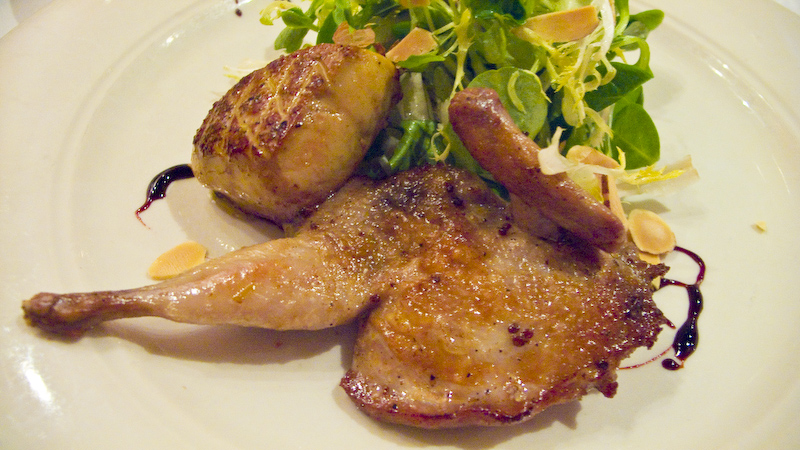Today we’re talking squab

Hello friends, and thank you for joining me on this wonderful week of September. Today, we’ll be talking about something a little different, but I’m writing about it anyway.
Today, we’re talking about squab. Squab is a dish made from pigeon! I’ll start off with this disclaimer: Squab is not a meal I will not ethically endorse. Squab is made from baby pigeon, usually a pigeon four weeks old or so. They can’t fly yet, so their meat is very tender and soft. It’s like pigeon veal.
Squab is a dark meat bird like duck and goose, and has a very delicate flavor, and is stuffed and roasted. Well, as stuffed as you can stuff a 12 to 14 ounce baby pigeon.
In some countries, squab is considered a delicacy because of its tenderness, rich taste, and because there’s so little meat per bird. The majority of meat is concentrated around the breast, making it flavorful and very lean. It’s also a good source of proteins, vitamins and minerals.
According to the D’Artagnan, a fine meats company, and one of the farm-to-table leaders in America, squab has been a delicacy for over a thousand years, and has been a domesticated poultry bird longer than chicken.
There is a common misconception that the “pigeons” that we see everyday are pigeons, but they’re actually rock doves, or called common pigeons, or rock pigeons, and are far less edible than food grade pigeon. Food grade pigeon, the kind raised for squab and other dishes, are a descendant of rock doves.
Food grade pigeon is a wide-spread delicacy meat, dotting around the world in culinary circles ranging from Cantonese, to Moroccan, and French tables.
I should also clarify that squab is the name of the meat source, and not the dish itself.
One squab dish is B’stilla, a meat pie with a sweet and salty profile made with a phyllo crust, and goes back to 15th Century Morocco, when Morocco was still part of the Moorish Sultanate that stretched into Spain during the height of its power.
D’Artangan also tells us, “Huge molded timbales of pasta, and molded domes of rice made with squab and rich accompaniments, were fashionable 16th and 17th-century Italian culinary showpieces.”
Squab farming was once a real deal occupation. Squab farmers would build roosts in their fields to attract wild pigeons, and then harvest the squabs from the roosts.
As my research unfolded, I found out that squab is legal in the U.S and are primarily raised in California, surprise surprise. They’re usually harvested when they weigh about a pound.
While squab farming seems like an easy job, it’s not a job I’d like to have.
A breeding pair of pigeons can produce up to 24 offspring a year. Both parents are involved in the raising of squab until harvested, though the male only participates if his wants and desires are met by his partner. If they’re not met, the male will peck her on the head, leaving her nearly bald, which makes it easier for squab farmers to gender their pigeons.
The harvesting process is less than fenessed. When harvest time rolls around, the farmer gathers the squabs in a box, and forcefully shakes the box. Those that can fly will fly out, and whoever doesn’t fly out is food-grade squab.
Because the squab can’t fly, they have underdeveloped muscle, which means it’s far less fibrous meat, thus it’s a legendary tender meat.
So if you have the heart to eat squab, what can actually be done with it?
Because squab is so small, so rich, and is such a delicacy, squab is usually used for horderves.
One dish by Chef Daniel Boulud is Tartine of Squab En Salmis. This dish is “garlicky grilled sourdough bread topped with squab, mushrooms and seared foie gras.” This stuff is well above my paygrade, but I can see its draw for a New Year’s party for people that make more than I do. I’m also not a big fan of literally eating bones, but you do you if that’s your thing.
So squab is a thing we all know about now. It’s not my kind of thing, but I’m not here to just talk about things I want to eat. And who knows, it might be your thing, and that is for you to decide, and if nothing else, squab is an interesting conversation piece.
Thanks for stopping by this week, and you can follow Speaking with My Stomach on Facebook, Instagram, and speakingwithmystomach.com.
Until next time, don’t forget to tip.
EDITOR’S NOTE: This is Chris Jaehnig’s Welcome to Speaking With My Stomach, a food column where we’ll be talking about food in all different kinds of ways; the history of foods and ingredients, how to cook them and celebrating the love language that is universal.





